The wonder boy from Moscow
 My friend Max loves to make predictions about future world champions. His current favourite is Daniil Dubov.
My friend Max loves to make predictions about future world champions. His current favourite is Daniil Dubov.
“Make no mistake about it. This boy will become world champion.”
“Did Magnus phone you last night and whisper in your ears, he will retire from chess?”
I asked mischievously.
“Now you are making fun of me. I didn’t say Magnus would retire or the boy would become world champion this year itself. OK, tell me who else among the young will become world champion?”
“I won’t make predictions like you. Currently, Carlsen takes at least three others seriously. They are Wesley So, Jan Duda and Alireza Firouzja.”
“Ah, I know, only yesterday Wesley So beat Carlsen in Opera Euro Rapid Final, 2½-1½. That’s commendable. Still I have a soft corner for this Moscow kid. He plays like Tal. Of course, I have heard about Duda. That’s the boy from Poland. Right? Isn’t he the boy who put an end to Carlsen’s string of victories last year?”
“Yes.”
“What about the other boy?”
“He beat Duda himself in that tournament!”
Firouzja shines
So it’s the other boy, Alireza Firouzja, that you see on the cover of this issue. In the magazine you will see both Duda and Firouzja in action against Carlsen in the Altibox Tournament, Norway. While Carlsen won the event on his home turf he has not had it easy with these young rivals, Duda and Firouzja. While Duda beat Magnus in their individual encounter, Firouzja had the satisfaction of coming second, right after the world champion. He drew with Magnus and overcame Duda in a terrific struggle.
A game that Romain Edouard annotates in this issue. I have given it a close look and also checked the commentary to the game by Jan Timman in New in Chess Magazine, 07/2020, as well as the analysis by Daniel Fernandez at ChessPublishing.com (October 2020). The result is a complex picture of a game with fluctuating fortunes.
However, I have kept it relatively simple for readers not familiar with modern practice.
I have also indicated lines where both sides can diverge from known paths.
You can replay the game without annotations first to explore the possibilities by yourself
After the game Duda commented, “I was surprised by the Caro-Kann. I didn’t expect it. My coach expected it, but I didn’t listen to him and then paid the price.”
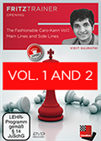 The Caro Kann is a very tricky opening. Black’s play is based on controlling and fighting for key light squares. It is a line which was very fashionable in late 90s and early 2000s due to the successes of greats like Karpov, Anand, Dreev etc. Recently due to strong engines lot of key developments have been made and some new lines have been introduced, while others have been refuted altogether. I have analyzed the new trends carefully and found some new ideas for Black.
The Caro Kann is a very tricky opening. Black’s play is based on controlling and fighting for key light squares. It is a line which was very fashionable in late 90s and early 2000s due to the successes of greats like Karpov, Anand, Dreev etc. Recently due to strong engines lot of key developments have been made and some new lines have been introduced, while others have been refuted altogether. I have analyzed the new trends carefully and found some new ideas for Black.
Jan-Krzysztof Duda v Alireza Firouzja | Photo: Lennart Ootes
One thing that impressed observers was the performance of Levon Aronian. Among others, he beat Carlsen, Caruana and Duda. Jan Timman devoted a whole article to him in a recent issue of New in Chess Magazine (08/2020). Four of his games are annotated by Michal Krasenkow and one by Romain Edouard in this issue.
Highlights from Sochi
This issue also offers games from the Russian Team Championships held in Sochi. I would have loved to see more coverage and annotated games here.
The Main Edition of the event allowed both men and women to participate and there was a separate edition for female teams. Aleksandra Goryachkina, the winner of the Russian Championship for Women, was the only female player to participate in the Main Edition.
This was like entering a lion’s den, and she fought hard round after round. However, time and again victory proved elusive as in the following position.
A challenge for readers
Nikita Vitiugov, her opponent, has captured the pawn on e4 with his rook. He knows he is courting danger and still thinks he can get away with it. The challenge for our young readers is to see how to overcome his resistance and remain on top:
Her final result was +0, =8, -1. Now, who did she lose to? We shall come to that soon.
As it happened, Медный Всадник, the “Bronze Horseman” from St. Petersburg, won the event. The “Horsemen” won eight of their nine matches and finished three points ahead of their closest rivals, FSM Moscow. The latter had the satisfaction of winning the women’s event, though.
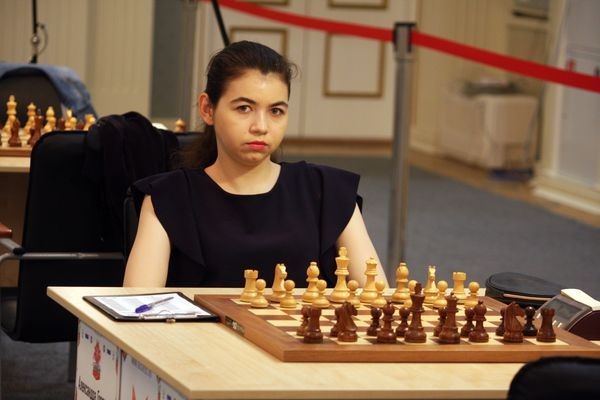
Aleksandra Goryachkina | Photo: Russian Chess Federation
To return to the Main Event, the top scorer of the “Bronze Horseman” team was Maxim Matlakov, who obtained 5½ points out of 7 (+4, =3, -0). However, I was impressed by the play of another talent, Vladimir Fedoseev.
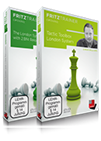 Simon Williams presents the London System, providing the theory you need for your games (7 h 16 min). In addition Williams also introduces into typical tactics and patterns in a seperate product. (53 games, 96 training questions and 3h 14 min)
Simon Williams presents the London System, providing the theory you need for your games (7 h 16 min). In addition Williams also introduces into typical tactics and patterns in a seperate product. (53 games, 96 training questions and 3h 14 min)A game, far from perfect. However, it’s full of imagination and fantasy.
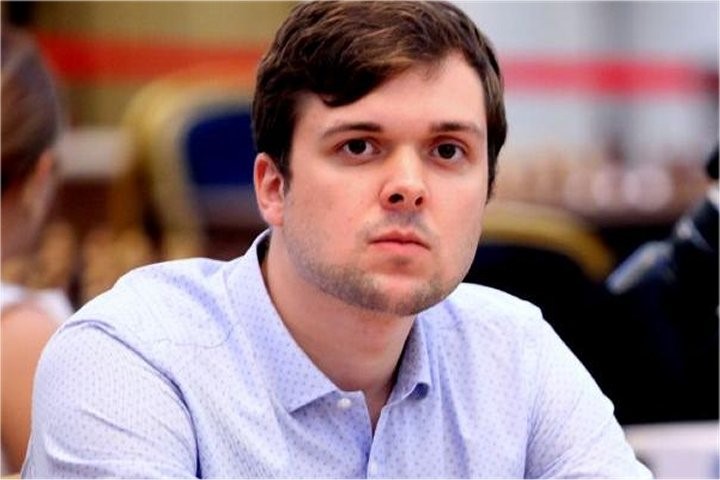
Vladimir Fedoseev
What about Dubov? Time and again he encountered tough opposition and was held to a draw. His one bright moment came in the following game and yes, it was against Aleksandra Goryachkina, her solitary loss.
This issue continues the historical series that commenced with CBM 197. Here we have the games from AVRO 1938, one of the greatest tournaments in chess history. As is known, Paul Keres and Reuben Fine finished first with 8½/14 points and Keres was declared winner on tie-break.
In this issue quite a few of the games from AVRO are annotated afresh from the 21st Century point of view. For reasons of space I shall not go into the historical detail.* This tournament had a star-studded field that included four world champions in history, Capablanca, Alekhine, Euwe and Botvinnik, with Samuel Reshevsky and Salo Flohr bringing up the rear.
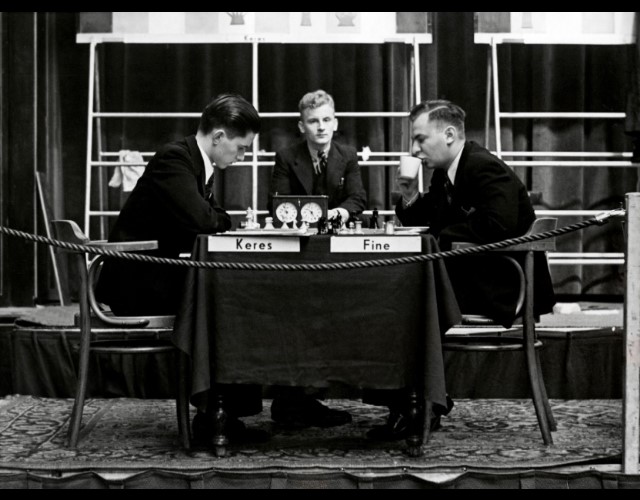
Keres and Fine | Photo: Spaarneestad Collection, The Netherlands’ National Archive
This brings me to the rest of the magazine. First, there is a special article on the 6.Rg1 line against the Sicilian Najdorf by Anish Giri. He has used the famous miniature Ian Nepomniachtchi v Magnus Carlsen (Legends of Chess, 2020) for his annotations. This offers state-of-art theory so to speak.
Another challenge for our young readers
I have a small bit of nitpicking on this rich piece of analysis. Anish Giri draws our attention to 16.Rga4, calling it a “slick” move (not sick, a typo) that would have won trivially. I think, it’s a precise move, the rook going on to capture the seventh rank and winning material.
The challenge for our young readers is to find the point of 13.Kf1!! found by Anish Giri and other commentators.
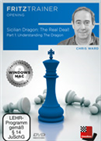 In this first part, the emphasis is on themes and ideas as the viewer is armed with tactical and positional motifs and concepts after 1 e4 c5 2 Nf3 d6 3 d4 cxd4 4 Nxd4 Nf6 5 Nc3 g6.
In this first part, the emphasis is on themes and ideas as the viewer is armed with tactical and positional motifs and concepts after 1 e4 c5 2 Nf3 d6 3 d4 cxd4 4 Nxd4 Nf6 5 Nc3 g6.
Apart from Giri’s work, there are as many as 12 opening surveys ranging from the Italian Game to the English Opening. I would like to deal with them in a separate review. For now, I would single out the surveys on the French, King’s Gambit and Modern Benoni for special mention.
Besides opening surveys, this issue has standard features on tactics, strategy and the endgame.
The main database of the issue has 440 recent games of which 16 are deeply annotated.
It may be noted that there are more annotated games in the sections on opening theory and training. Well, practice makes perfect.
*Historical notes
1) The uninitiated reader would find more on AVRO1938 here.
The knowledgeable reader could try the contemporary American magazine, Chess Review. It came up with a series of reports followed by games from the tournament. They are still available from the USCF archives (December, 1938).
(See the January 1939-May 1939 issues)
2) Among the participants, Keres, Fine and Botvinnik annotated their best games in their game collections. Max Euwe wrote a whole book, AVRO’s Wereld-Schaak-Tournooi.
It’s in Dutch. Russian readers may give АВРО-Турнир (2006) by G. G. Toradze a try.
English readers have a choice between A.V.R.O. 1938 by Arthur Antler (1993) and AVRO 1938 International Chess Tournament (2010) by Dale Brandreth and Robert Sherwood. The first is an easy, enjoyable read and the second, richly detailed and well-analysed.
Links


















 My friend Max loves to make predictions about future world champions. His current favourite is Daniil Dubov.
My friend Max loves to make predictions about future world champions. His current favourite is Daniil Dubov. 








